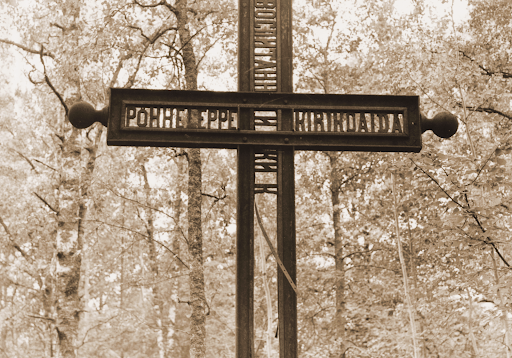Kummistu Cemetery

The Kummistu Cemetery was established in the middle of the 19. century. The oldest remaining tombstone is dated Oct 20, 1851 (Ingel Baio (Paju). The cemetery on a small hill was in use for half a century, until the surrounding lowland area was full. The new cemetery in Pühalepa at the Suuremõisa-Kerema road was opened in 1900 and is still in use. The area of the Kummistu Cemetery is 0.56 ha.
There are approximately 400 tombstones preserved and approximately 1300 (1269) burial sites here. The latest tombstone is dated March 5, 1924 (Ann Liik). Most of the grave sites are abandoned. Besides the tombstones, the limestone gateposts (0.8 x 0.8 m) located at the west and east entrances are also noteworthy. There is also a large, several meters high cross, made of railway ties by the pastor Sengbusch (the pastor in Pühalepa 1822−1877) with a writing PÖHHELEPPE KIRIKOAIDA ja ВОСПИТАННИКИ К [ОМИССАРОВСКОГО ТЕХНИЧЕСКOГО УЧИЛИЩА]. Meaning PÜHALEPA’s CHURCHYARD. (Half of the letters are lost. The writing on the vertical beam marks the donors – pupils of the technical school of Petersburg, who’s headmaster was the son of the pastor Johannes von Sengbusch. The year used to be on it as well, but it has also been lost).
Only peasants are buried in Kummistu Cemetery. The only distinguished people who are buried here would be the family members of the pastor Alexander von Sengbusch. Their graves are located in the southwest corner of the cemetery.
The Kummistu Cemetery represents a good cross section of the community of that time period – there are parish clerks, innkeepers, cabinetmakers, a church organist and many good country folk and tradesmen, squatters, the parish poor, etc.
The side road leading to the Cemetery and the Cemetery itself were restored by the Pühalepa community in 2016.
It is a waypoint on the journey
You might also be interested in:
